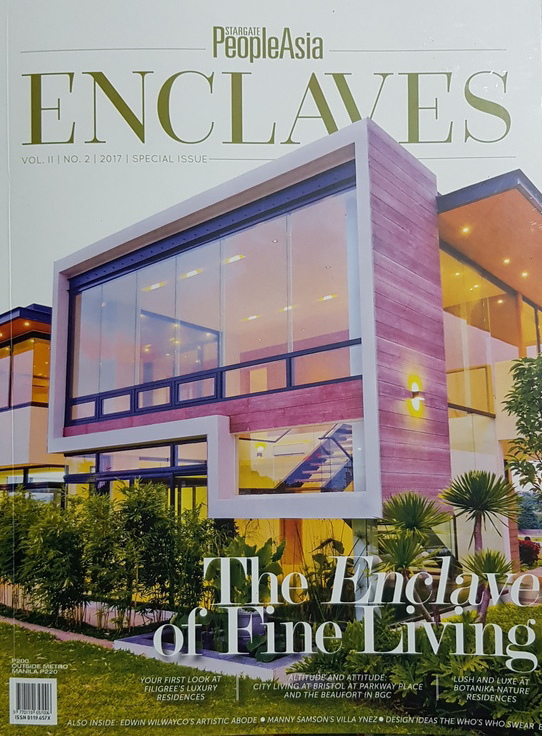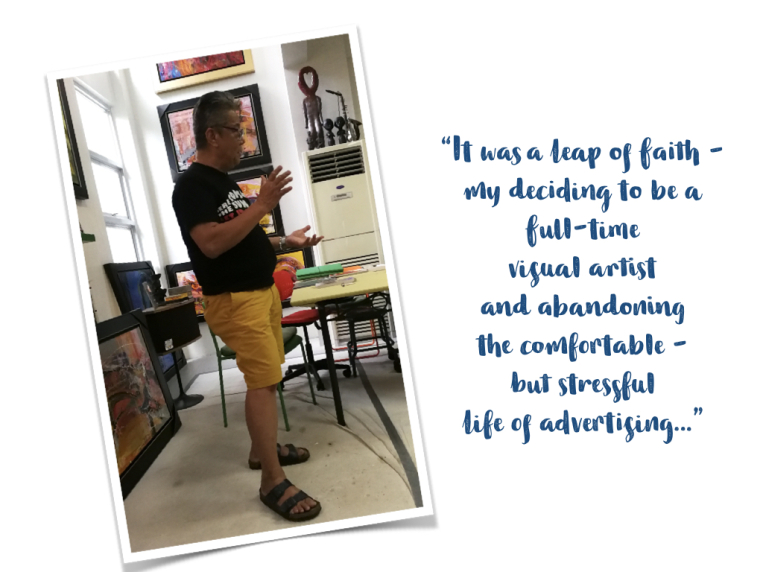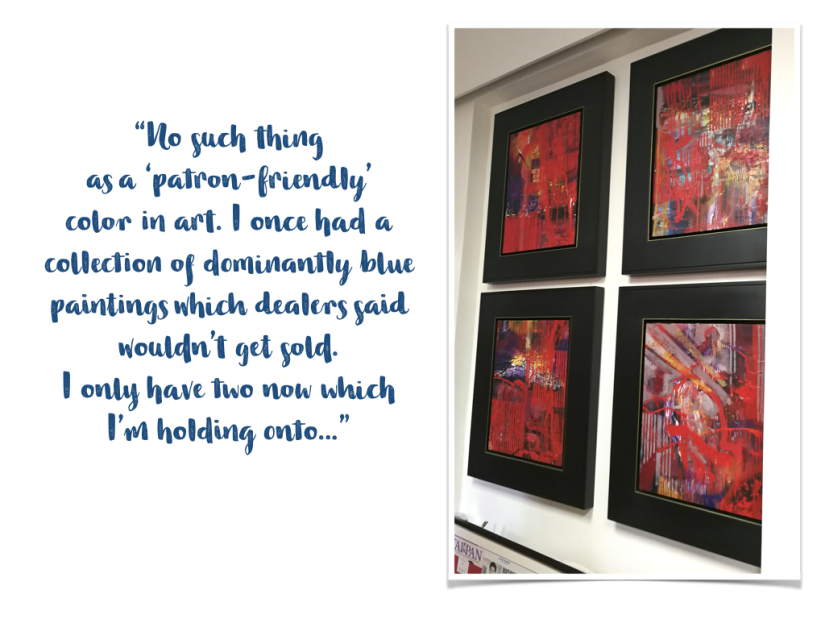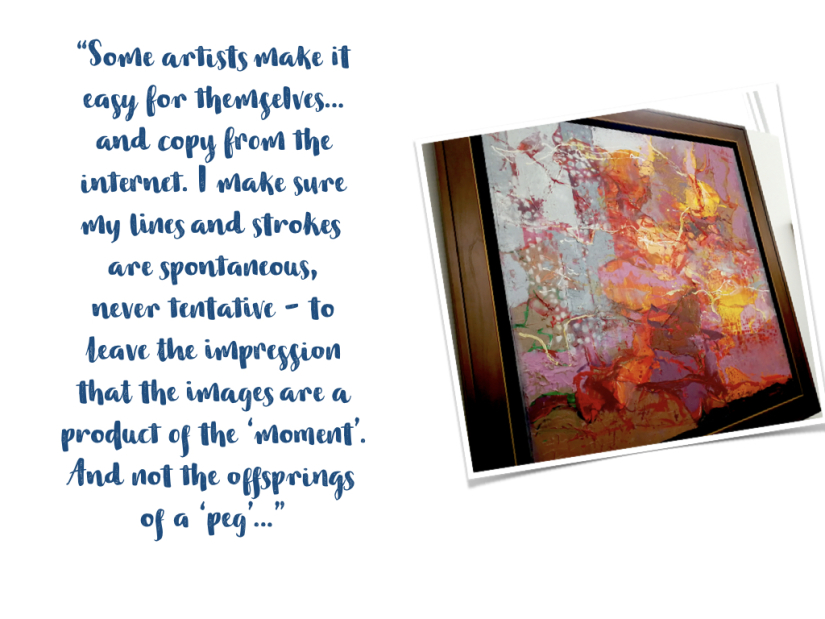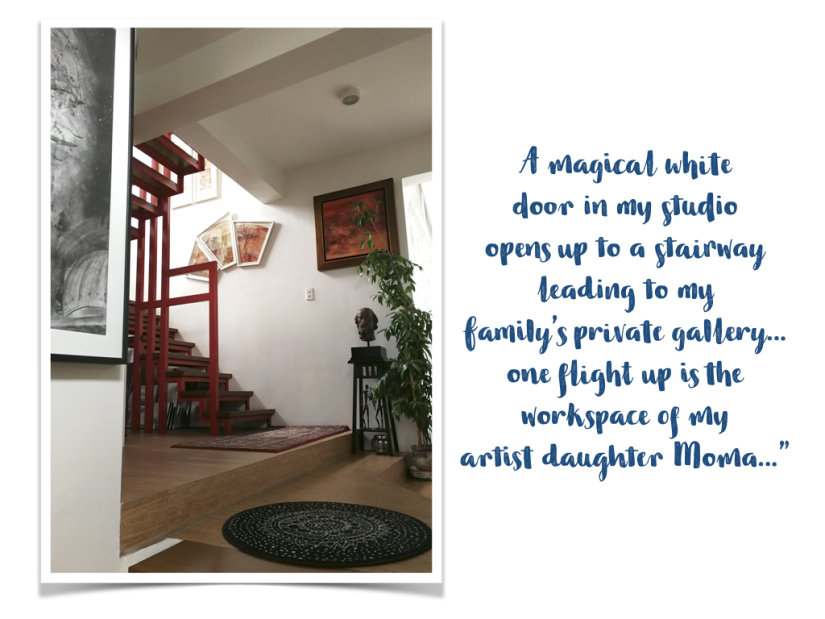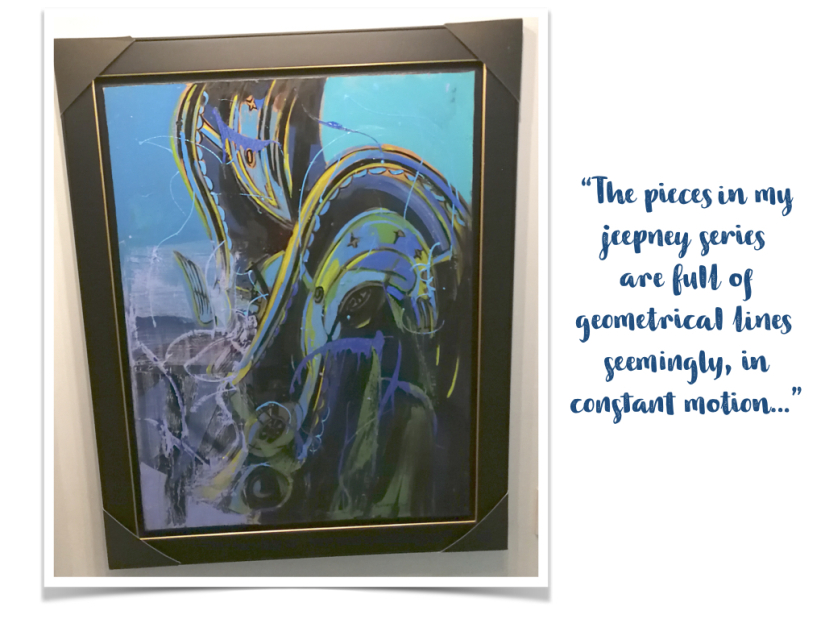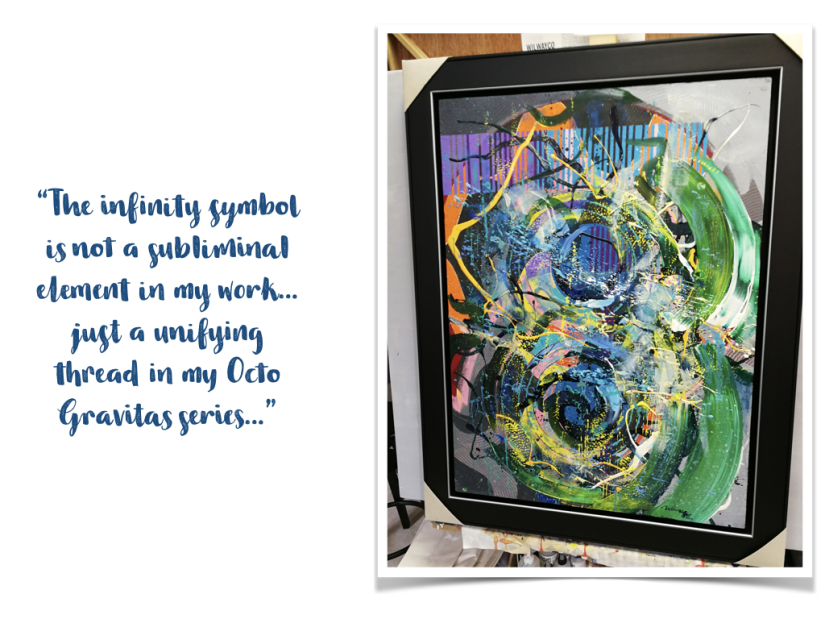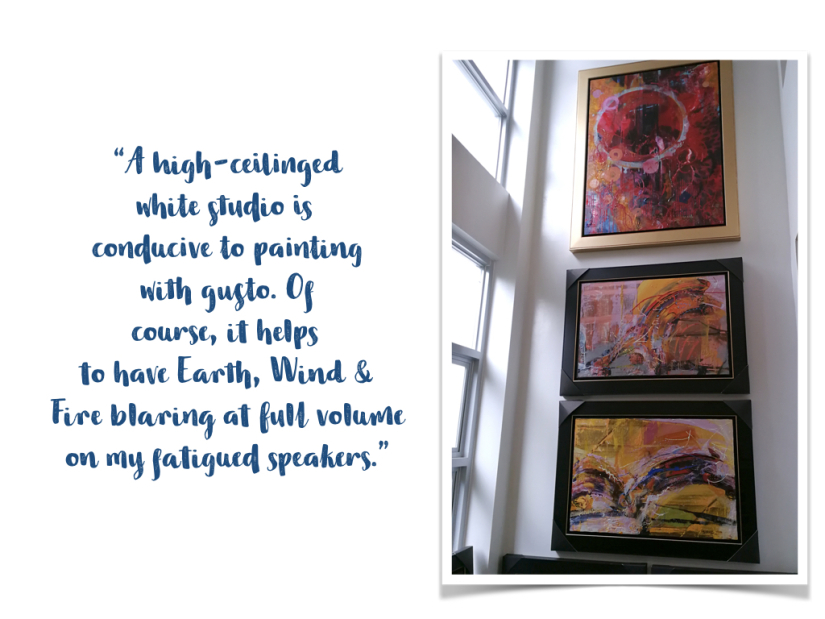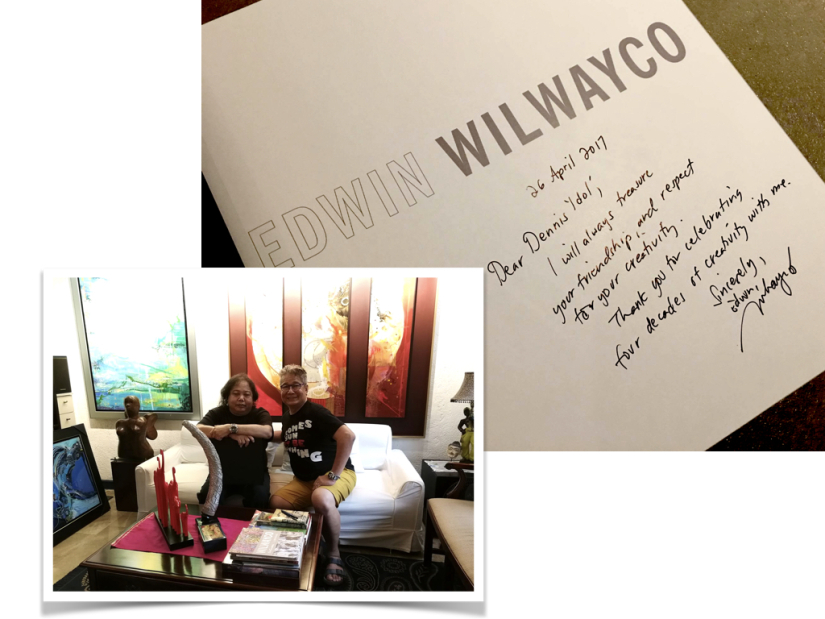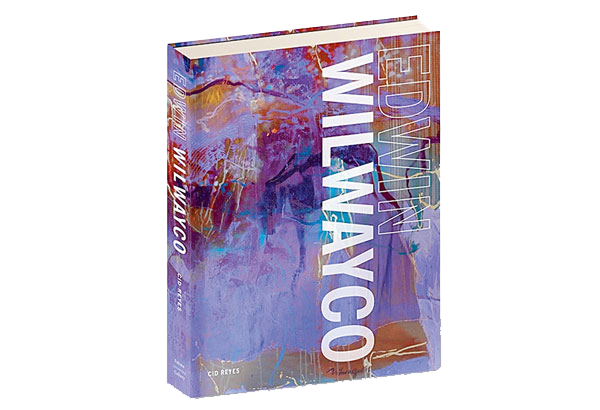Written by: Joanne Rae M. Ramirez (The Philippine Star)
Date: Thursday February 22, 2018
Artist Edwin Wilwayco at home.
Hinahanap hanap kita Manila
Ang ingay mong kay sarap sa tenga
Mga jeepney mong nagliliparan
Mga babae mong naggagandahan
— Manila by Hotdog
At first, I thought they were koi swimming in opposite directions in a crowded pond, leaping out of the canvas.
“Actually, they’re jeepneys,” smiles “master abstractionist” Edwin Wilwayco.
Indeed, the jeepney was leaping like a koi as it weaved in between cars and pedestrians in the congested concrete tributaries of Manila. Typical of Wilwayco, the painting was nothing short of “kinetic.”
That painting, along with about a dozen others adorning one wall in Wilwayco’s home (several more are in his adjacent studio), will be part of Edwin’s forthcoming exhibit at Manila House titled Jeepney Sinfonia. Each painting is indeed a symphony loud and clear, I could almost hear it.
Outside the box, where Edwin’s mind often dwells, the jeepney is driverless and becomes animated after dark, and the street becomes its stage and the lamplights turn into klieg lights. “Imagine a jeepney coming alive at night or in the sunset when the driver isn’t in the vehicle and the jeepney plays and dances and whatever.”
In 1989, Wilwayco had a show Jeepney Fantasia in the old Ayala Museum. “If I remember correctly, I had exhibited 18 paintings — those were very big ones. But now, I don’t have any left from that exhibit for my family; they were all sold out,” reminisces Wilwayco. “Once in a while, I get asked by clients if I’ll ever go back to painting the jeepney. I would say, ‘Maybe one of these days’.”
Well, the day has come. Wilwayco has taken the “jeepney” out of the garage for a spin, sirens blaring. If you have ever ridden a jeepney, you know that many of them are mobile discos (yeah, that kind of music) sans the dance floor. You hear the beat even after the jeep has sped away. A new fan of Wilwayco, I like to think of his paintings this way — blaring, blazing. May ingay (They create a buzz).
“When I started working on this in early 2016, I hadn’t heard of the government’s plan to phase out the jeepney,” reveals Wilwayco. “And when I read it, I said, ‘I might as well push through with it’.”
Jeepney Sinfonia 6, 2017, oil on canvas, 29.75” x 24” (76 cm x 61 cm).
Without meaning to, Wilwayco has just created his own monument to a Filipino icon that is past its prime. Before the jeepney is consigned to the garage of our memories, is he inadvertently taking it out for a last dance, perhaps?
His first dance with the jeepney left him breathless. But that first jeepney exhibit, Jeepney Fantasia, was actually his resurrection.
It followed a heartbreaking exhibit 10 years earlier that made him almost store his paintbrushes for good.
“I did my flag series in 1979, which was a flop at the time. I was very young then and I got good art reviews. My paintings were featured in magazine covers. For the first time in my career, I asked for a loan from the bank for P22,000 just to finance the cocktails, framings and a simple catalogue,” Wilwayco looks back.
Alas, he sold only one painting from that exhibit, for P2,500.
“Back then I was just earning P1,300 a month and I said to myself, ‘Maybe the sale will come in towards the end of the show.’ The show ran for a month but nothing came.”
Depressed, Wilwayco retreated into his shell. “I only shared my frustrations with my wife Loby. I didn’t paint for one year, didn’t want to read anything about culture or attend any art openings. By God’s grace, I bumped into Dr. Rod Paras-Perez from UP also, and an art historian and printmaker. And he made me shed a tear when he told me that art is not like that. He suggested that I apply for a British Council grant and I did. I stayed there for six months in Surrey. After that, I was back.”
Back in front of his easel again, Wilwayco remembered what his professors in Surrey told him. “I owe them a debt of gratitude because they suggested that when I get back to my country, I should think of something unique to the country. At the time, I said, ‘I might as well do the jeepney’.” And the Jeepney Fantasia became a reality and a resounding success.
It took almost 30 years since then for Jeepney Sinfonia to join Wilwayco’s motorcade of exhibits.
“I said that I might as well go back to the jeepney, and I am also thinking of going back to the flag but in another light. The first jeepney series I did for Ayala Museum was a deconstruction of the jeep so it was very visible -— the image of Mother Mary inside the jeep, the horses on the roof, and the fender. Now for Jeepney Sinfonia, it’s more kinetic,” he explains.
“I told myself that I should go back to abstract figuration,” he adds, pointing to the figure of the jeepney in one painting. He calls my attention to the steering wheel, which when seen from a certain vantage point, actually looks like a crucifix!
Jeepney Sinfonia 12, 2017, oil on canvas, 24” x 36” (61 cm x 91 cm).
His exhibit at Manila House at the Bonifacio Global City “was not planned.”
“I don’t have any schedule,” says the artist, a UP Fine Arts graduate, and who now spends half the year in the US. “I think I created 65 paintings and all of the paintings were done in the US. I e-mailed the framer the measurements about a month and a half before I arrived and I specified the color and the trimmings.”
After a lunch meeting with representatives of Manila House a few weeks ago, the exhibit Jeepney Sinfonia was set into motion.
Most of the paintings in his past exhibits are sold out, and Wilwayco has had to buy back his own paintings from collectors for his wife and only child Moma (an artist herself) to keep. In fact, the unsold paintings from the “flop” flag series in 1979 sold like hotcakes eventually, when Wilwayco became a name in the art world. After all, this Novo Ecijano has had 30 solo exhibits and several group exhibits all over the world.
“I learned my lesson; I try to keep one or two paintings for the family. Aside from keeping some to provide for my family, at the same time, I want the rawness of the painting done in that specific time. By ‘rawness,’ I mean that at that specific time I was painting like that. Of course, (my style) progresses,” says Wilwayco.
On our way to his studio, we pass by two framed nude sketches, a seeming oddity amid his colorful abstracts and abstract figurations.
“I was thinking that if a museum gives me a retrospective before I die, at least they can see that I know how to draw,” he chuckles.
source: http://old.philstar.com/newsmakers/2018/02/22/1790012/jeepney-sinfonia-how-edwin-wilwayco-creates-music-jeepney




